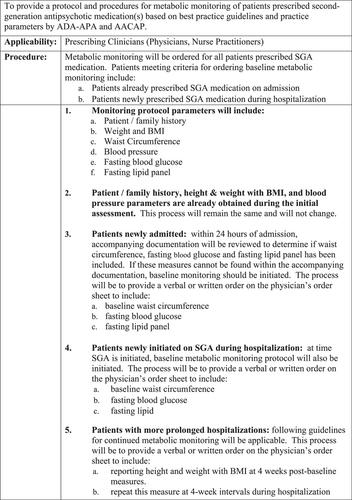Metabolic monitoring of pediatric patients prescribed second-generation antipsychotic medication
Abstract
Introduction
The prevalence of psychotropic medication prescription use in youth has increased over the past several years. Despite recommendations and practice parameters established by the American Diabetes Association-American Psychiatric Association (ADA-APA) outlining metabolic monitoring of patients prescribed second-generation antipsychotic (SGA) medication, monitoring adherence for the pediatric patient population remains inadequate.
Aims
This project aimed to improve metabolic monitoring of pediatric patients prescribed SGAs and discharge recommendations for follow-up monitoring within a small, child, and adolescent psychiatric hospital.
Methods
This project compared metabolic monitoring adherence rates pre and postimplementation of a metabolic monitoring organizational policy developed to provide procedural guidance, using ADA-APA guidelines. Participants included prescribing clinicians (physicians and psychiatric nurse practitioners).
Results
Phase 1 chart reviews found no records of fasting blood glucose, fasting lipid profile or waist circumference. Following project implementation, chart review found that fasting blood glucose and fasting lipid profile was recorded in 21 (72.4%) of the charts, and waist circumference was recorded in 18 (62.1%) of the charts for patients prescribed SGA medication. For patients discharged on an SGA, written recommendations for follow-up metabolic monitoring improved from 13% to 70% (<0.001).
Conclusions
Implementing an organizational metabolic monitoring policy and protocol can improve clinician adherence to ADA-APA guidelines for recording in-patient monitoring of metabolic parameters and discharge recommendations for pediatric patients prescribed SGA medication.


 求助内容:
求助内容: 应助结果提醒方式:
应助结果提醒方式:


